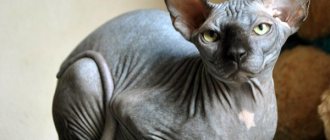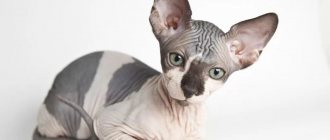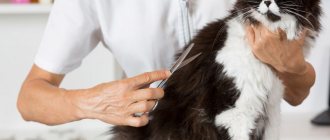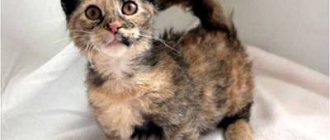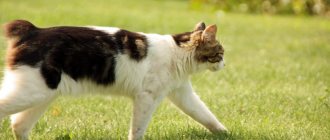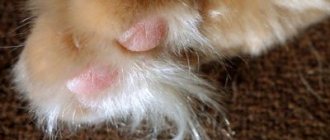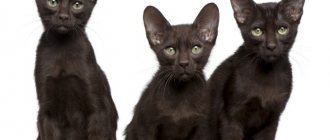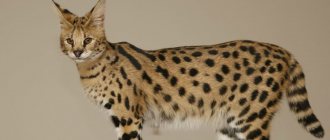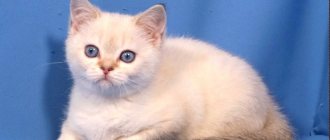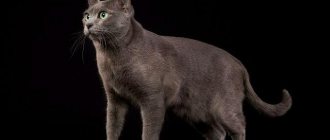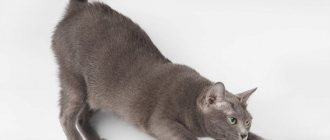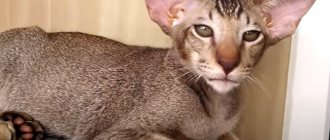Bambino
- Fact 1:
The Bambino cat really resembles a baby - touching and fragile, whom you want to take in your arms and caress, protect. - Fact 2:
Sphynx cats have amazing grace and sophistication, but bambino cats have not inherited these qualities. - Fact 3:
Despite its awkward appearance, the bambino can make unexpected pretzels on its short legs. - Fact 4:
It is because of their hairlessness that bambinchies are more susceptible to dermatitis than their counterparts
The best discoveries are made by chance... This also applies to new cat breeds. Breeders are trying to create something amazing, original, and sometimes a mutation forms the basis of such a breed.
A mutation is a stable change in the genotype of a living creature that remains in the cells and can be inherited. It should be noted that a mutated organism is a kind of “mistake” of nature, therefore such individuals are not always distinguished by good health and longevity.
To imagine a cat mutation, it is enough to remember such a breed as the Munchkin: funny short legs are the Munchkin’s calling card. And the beautiful bald eared cat, the Canadian Sphynx, causes even greater delight among cat breeders. Breeders appreciated the amazing “highlights” of these two breeds and decided to create the unimaginable - a hairless cat with short legs, which received the cute name “Bambino” (translated from Italian as “child, baby”).
The Bambino cat really resembles a baby - touching and fragile, whom you want to take in your arms and caress, protect. But many cat lovers ask a very logical question: is it worth having a bambino cat at home? Despite its external splendor, does such a pet perhaps need special care?
Brief history of the breed
Bambino is a young breed that appeared thanks to the Osborne couple from the USA. They owned the popular HolyMoly Cattery cattery and in the early 2000s acquired a cute kitten with short legs who had a congenital genetic mutation.
The couple were so fascinated by the animal's unusual appearance that they decided to try to breed a new breed.
The munchkin and the Canadian Sphynx took part in the creation of the bambino. This is what explains the extremely low set, hairlessness and elongated body of the bambino. In 2005, dwarf hybrids were introduced to the public. At the same time as the Americans, experiments on breeding cats with short legs were carried out in the Russian nursery Baby Moon Cattery.
His owners Elena and Maria Chernov, like the Osbornes, bred munchkins with Sphynx dogs. True, the short-legged cats they bred were not related to American bambinos and had a unique set of genes. To date, the breed remains unrecognized by most felinological organizations, and TICA has assigned it experimental status.
Bambino cat health
The bambino breed was bred quite recently - in 2005, so there is no data on their life expectancy. Felinologists say that on average they will live 13–15 years, but with good care they can live up to 18–20 years.
Bambinos, unfortunately, do not have a strong enough immune system, so you need to keep the house clean and prevent them from interacting with foreign animals - they can easily catch an infection. It is also important to get vaccinated in a timely manner.
There is not yet enough data on genetic diseases, but felinologists say that bambinos are prone to developing cardiomyopathy, which was passed on to them from sphinxes. With this disease, the wall of the heart ventricle thickens, resulting in its volume becoming smaller. As a result, the amount of blood that can be pumped per heartbeat decreases.
The disease has no cure; the veterinarian can only prolong the cat’s life by prescribing medications. The consequence of the pathology is chronic heart failure and death of the cat. Even with the help of ultrasound, any pathological changes are not always detected, so it is better to initially ask the breeder to confirm that the kitten’s parents are healthy. In the early stages of the disease, there are no characteristic symptoms; in an advanced state: shortness of breath, weakness, and sometimes paralysis of the limbs.
Another common bambino disease is Malassezia dermatitis. The causative agent is the yeast fungus Malassezia. It is present on the skin of healthy cats, but under favorable conditions (poor hygiene, stress, hypothermia) it begins to multiply. The first signs: severe itching, inflammation, redness, alopecia, damage to the claws (a brown coating appears). Your cat may have an unpleasant sweet odor.
The disease is easily diagnosed: laboratory specialists will take a scraping from the skin and examine it for pathogenic microflora. Treatment should be prescribed by a veterinarian. Usually the cat is washed with antifungal shampoo and wiped with chlorhexidine or a weak solution of acetic acid. These substances create unfavorable conditions for fungal growth. Antimycotic creams or ointments (Candide, Clotrimazole, Miconazole and others) are also applied to the affected areas.
If cats of this breed are not properly cared for, there can be very sad consequences, including serious infectious diseases, because they do not have fur to warm them and protect them from cold air. If you don’t wash your cat, there may be various inflammations and suppurations, because the bambino’s skin is folded and has many sebaceous glands.
The structural features of cats do not affect their health in any way. The only exception may be the disease dysplasia, which some kittens inherited from their Munch ancestors. But this disease is easy to diagnose. If the kittens are weak and their hind legs seem unnaturally twisted, then you should consult a veterinarian, because such an animal is most susceptible to various fractures and dislocations, and there may be problems with the spine.
READ How to train a cat to use the toilet - the most effective methods
For your information! In total, cats of this breed live an average of 14 years if they are properly cared for, vaccinated promptly and follow the recommendations of veterinarians.
Breed description, standards, appearance
Bambino is a cat with short legs, large ears and a hairless, elongated body. Although it belongs to experimental breeds with an unsettled phenotype, it has long had its own standard.
Dimensions and weight
Bambinos are miniature short-legged cats with pronounced sexual dimorphism. Females are about a quarter lighter than males. The average weight of a cat with short legs is 2-4 kg.
Anatomical characteristics
Bambinos are hairless cats with large ears and short legs. Their physique resembles the Minskins, but they have a number of significant differences. A typical Bambino should fit the following description:
Color and coat type
Bambinos are hairless cats with thick, folded skin and a good layer of fat reserves. Most of the “wrinkles” are localized on the animal’s face, neck, shoulders, forelimbs and between the ears.
On a note. A Bambino cat can be not only completely hairless, but also half-haired. On the legs, bridge of the nose, tail and the outer part of the ears of such individuals there are light light hairs. And the bodies of individual representatives of the breed are covered with short velor pile, the length of which does not exceed 2 mm.
The color of a cat with short legs can be any color, with the exception of zonal. Blue, black and white representatives of the breed are considered especially valuable.
Possible breed defects
Flaws in appearance, in the presence of which a bambino cat will not receive the highest expert rating:
How much does a bambino cost, and where can I buy it?
Many inexperienced owners, having come across an advertisement on the Internet for the sale of a bambino cat at an affordable price, get an ordinary Sphynx. The seller can assure you as much as he wants that the recessive gene for short legs will appear in the descendants, but you will never see it. You need to be extremely careful with unverified sources. There are even known blasphemous cases when a seller shaved the head of an ordinary cat and passed it off as a bambino.
This young and rare breed can only be purchased at a specialized nursery. But in 2021 there were only 10 such nurseries in Russia. Don't expect to start breeding bambinos behind the back of the breeders either. Kittens are sold without the right to further breeding. Babies are spayed/sterilized before sale. Baby bambinos are tender, touching lumps, covered with many deep folds, half of which will smooth out completely by the age of 2.
Such a pet costs between 70-100 thousand rubles, but sometimes breeders make discounts due to some external defects of the kitten. If you still want to buy a bambino for breeding, then the price of such a pleasure will reach 4 thousand dollars or more.
Character and temperament
Bambinos are mischievous, playful and incredibly sociable animals that love to interact with their owners and require a friendly attitude from people.
Funny cats with short legs are very attached to all family members, but they single out a leader for themselves and follow him everywhere. Bambinos left alone begin to get bored, so you need to leave more toys for them.
The sociable and playful nature of cats of this breed helps them get along well with children and even become inseparable friends with them.
Non-aggressive bambinos are completely devoid of hunting instincts and easily find a common language with dogs, ornamental birds, rodents and aquarium inhabitants.
How to choose the right kitten
This cat breed is difficult to breed and is considered quite rare. It is much more difficult to get exotic kittens from mating two bambinos than from mating a Sphynx with a munchkin. About 25% of embryos die in the womb, which means cats with short legs usually have small litters.
Another part of the kittens have long limbs and are not in particular demand among buyers. Therefore, the search for a potential pet may take a long time.
When choosing a bambino kitten, you should be guided by the following criteria:
- presence of documents;
- presence of basic breed characteristics;
- behavior;
- health status.
Kitten care
Up to 3 months, bambino kittens need maternal care, which means it is extremely undesirable to take them before this age. They learn basic skills from their mother and learn to interact with the world around them. Therefore, 12-week-old kittens from good nurseries come to their new owners already quite independent. Of course, the little bambino needs to be given time to adapt to the changed conditions and shown where he can eat, sleep and go to the toilet.
To prevent any troubles from happening to the kitten during the process of getting to know the new home, decorative plants, detergents, wires and fragile objects are removed from it in advance. And in order to protect the inquisitive bambino from falling, his access to open windows and balconies is limited.
Tips and tricks for buying a bambino
Since this breed is quite new, finding it in Russia is not an easy task. Most often they can be found in nurseries specializing in breeding Sphynxes.
If you are planning to buy a bambino kitten, you should contact a cattery, for example, “Murmulet” and the like.
You need to beware of scammers and never leave an advance payment. You should definitely ask the breeder how they feed the kitten and how they care for it. Before purchasing, you need to carefully examine the animal.
It is worth considering that this is far from the cheapest breed. The average cost of a kitten is 80-90 thousand rubles.* An animal that can be bred will cost much more. You need to prepare for an amount of more than 360 thousand rubles.
In any case, having such a cat is a big responsibility. Due to the peculiarities of the structure, there are a lot of problems with proper care: there are no drafts, they are constantly cold, and they can get colds. Therefore, you should think 300 times before buying such a kitten.
*Prices are as of September 2021.
Care and maintenance
Due to the lack of fur, bambinos cannot tolerate cold, dampness and drafts. You need to maintain a comfortable temperature in the room and arrange several insulated beds in the form of nests.
On a note. Some breeders recommend choosing a warm wardrobe for the bambino. Clothing for a cat with short legs should be tailored to fit so as not to restrict the animal's movements.
Hygienic care for a cat of this breed comes down to simple but regular procedures:
Bambinos sweat and secrete sebum, and dirt and dust quickly accumulate on their bodies. Therefore, representatives of the breed need regular washing. It is advisable to bathe cats with short legs at least 2-3 times a month, otherwise they will begin to emit an unpleasant odor.
Exterior
In appearance, bambinos are very similar to the Canadian Sphynx. They have the same muzzle, identical body structure, and coat quality. Only the length of the limbs differs.
Bambino is often compared to a dachshund due to its short legs and elongated body.
Thick paw pads are a distinctive feature of the bambino.
Possible defects:
- frail physique, underdeveloped muscles;
- defects in the structure of the tail (kinks, fused vertebrae);
- short body;
- excessive amount of hair.
The color point color is found not on a milky, but on a gray background. The gray monochromatic body color is very beautiful. The white color is the most popular. A black cat is a valuable specimen for breeders. Bambinos have multi-colored eyes (heterochromia)
Feeding the cat
To ensure that the short-legged hairless cat receives all the necessary vitamins and minerals, he is provided with a balanced diet. Many breeders recommend feeding bambino high-quality premium or super-premium dry food.
When choosing a brand, you should give preference to products from trusted global manufacturers, which do not add soy, corn, dyes or preservatives. The following foods fully meet these criteria:
- Royal Canin;
- Farmina;
- Pro Plan;
- Gemon.
If a bambino eats natural foods, its diet should contain at least 70% meat. Twice a week, chicken, beef or turkey is replaced with ocean fish and offal. Also, representatives of the Bambino cat breed must be given vegetables, eggs, cereals and dairy products.
In order not to harm the animal, the following are completely excluded from its diet:
- fat meat;
- river fish;
- sweets;
- smoked meats;
- baking;
- sausages;
- any food from the master's table.
The little story of baby Bambino
When the first short-legged cat cub appeared in the world, the joy of the breeders knew no bounds. They put great effort into preserving the genotype. This is how munchkins appeared, which, by the way, became the ancestors of not only bambino cats, but also kinkalow, skookum, and napoleon. In 2000, an American couple of Osborne breeders from Arkansas bought a strange hybrid from their colleagues - a hairless kitten with tiny paws. In those days, the cub did not have a breed or even a nickname.
The couple decided that the kitten deserved world recognition, and they were not mistaken. The Osbornes themselves were engaged in breeding Canadian Sphynx cats, and with the help of their genes they were able to fix the mutation they liked. The first kitten, which fully met the breeders' expectations, was named Bambino (it looked very much like a baby).
The nickname soon became the name for a new breed, which for a long time was not recognized by international associations of cat breeders. It was only in 2006 that the bambino was registered as an experimental breed, and the cats still have no official status. But Bambinchies are included in the Exotic Cat Association (REFR) and the Dwarf Cat Association (TDCA). Now the breed has a lot of fans around the world.
Education and physical activity
Despite their mischievous nature, bambinos are easy to train. Cats with short legs easily get used to the feeding schedule and quickly master the skills of using a tray and scratching post. In addition to the basic rules of behavior, representatives of the breed are able to remember about 10 commands like “Come to me!” or “Bring it!”
Nimble and active, bambinos have anatomical features that limit their jumping ability. Therefore, they do not need high sports complexes. And so that cats with short legs have something to do, they buy a lot of toys for them.
Characteristics of bambino cats
The bald short-legged dog, whose skin resembles delicate velvet, has a pleasant character. These are cats who prefer to spend a lot of time playing. They are motivated to spend their time in this way by curiosity and activity.
global $ads_google; //data-ad-slot=”2475549904″ $ads_google = empty($ads_google) ? false : true; ?> if ($ads_google == false) {?>
$ads_google = true; ?> } ?>
Short legs are not an obstacle to running around the house. You can compare a bambino cat with a ferret both in terms of activity and level of curiosity.
Since childhood, a bambino kitten becomes attached to people in the house. This love will remain for the rest of the little one’s life. A person who is looking for a cute companion at home will not go wrong if they choose such a kitty!
Thanks to their natural curiosity - cats can handle travel and moving well if their beloved owner is nearby.
The breed is friendly and sociable, which guarantees good relationships with different pets. Kotofey will purr equally kindly with a dog, another cat, a rodent and a bird. If children live in the apartment, then it will be good for everyone: the bambino kitten ends up in the world of games. This is great for a small cat, the main thing is to teach children not to offend the bald, folded creature.
The length of the legs and their strength allow the bambino to stand on its hind legs, like a squirrel. At the same time, he looks funny, which touches any heart.
Attachment to the owner does not mean that the cat will purr at your side around the clock. These are not obsessive pets.
Raising and training a pet
The Bambino cat, although naughty, can be trained without any problems. At first, the kitten adapts to its new home, and later you can begin training.
The tray is placed next to the cat’s house right away: the baby is clean, so the toilet will be used for its intended purpose.
Then you can teach the naked baby to the feeding regime, to the scratching post. The intellect is good, the funny descendant of the sphinx and the munchkin understands what his owner wants from him.
The breed learns different commands with regular and proper training. Training begins at six months, lessons are held in the form of a game and last 3-5 minutes.
Health and susceptibility to disease
The average lifespan of a bambino is 12-14 years. Relationship with sphinxes and munchkins affected not only the appearance, but also the health of these hairless cats with short legs.
From the former they inherited a predisposition to hypertrophic cardiomyopathy, from the latter - a tendency to lordosis. In addition, representatives of the breed are susceptible to sunburn, dermatitis and colds.
Vaccinations and antiparasitic treatment
To prevent viral and infectious diseases, bambinos are routinely vaccinated against panleukopenia, calcivirosis and rhinotracheitis. The first vaccination for a kitten with short legs is given at 7-8 weeks. After 28 days, the bambino is vaccinated against the same diseases and against rabies. Subsequently, a cat of this breed is vaccinated once a year.
Important! Many vaccines are contraindicated for Bambino. Therefore, the drug should be selected by a veterinarian familiar with the characteristics of the breed.
Anthelmintic treatment of bambino is carried out twice a year with mandatory repetition after 10-14 days. The dosage of anthelmintic drugs is adjusted depending on the weight of a cat with short legs.
Buying a kitten
A bambino kitten with documents is quite expensive - 30 - 300 thousand rubles, depending on the class. The Pet class is the most affordable; these are pet kittens that have already been sterilized and cannot participate in breeding. Most often they have minor defects that do not affect health in any way, but because of them the kitten cannot participate in exhibitions.
Currently in Russia there are several nurseries that breed bambinos:
- Lunabella (Moscow);
- Magnificent (Sochi);
- Murmulet (Moscow);
- Shococats (Moscow);
- Smart (Murmansk).
When buying a kitten, you must make sure that it is healthy. The breeder must provide information about all medical tests and vaccinations performed.
There is no such person who would regret having a bambino kitten. These cute funny creatures will always cheer you up, become a good friend to your child, and will not create problems in the house. The only significant drawback is the high price, which is due to the complexity of breeding the breed.
Pros and cons of the breed
Bambinos, like cats of any other breed, have not only advantages, but also disadvantages:
ProsCons
| Original exterior | Difficulty in breeding |
| Friendly disposition | High cost of kittens |
| Love for children |
Bambinos are cute dwarf cats that inherited from their ancestors not only their funny appearance, but also their wonderful character. After all, sociable and playful pets with short legs quickly fit into the family and become everyone’s favorites.
Breeding
Bambinos, like representatives of any other breeds, need to be spayed at the age of 8 – 12 months. Kittens are often sterilized by the breeder to prevent the possibility of breeding by a new owner.
Bambinos are very difficult to breed. It is not advisable for those who do not have such experience to do this. When mating two dwarf individuals, approximately 25% of the embryos are not viable. Therefore, a cat most often has no more than 3–4 kittens in a litter.
The female's first estrus occurs at the age of 7–8 months. But in order to have a higher chance of getting healthy offspring, animals must be bred at the age of 1.5 years. It is advisable to choose an experienced male. If he does not have experience in covering a cat, conception may not occur due to stress. You also need to make sure that the cat is healthy and does not have genetic diseases.
It is important to prepare partners for this process. A month before mating, animals need to be dewormed and vaccinated two weeks later. Immediately before the procedure, their claws should be trimmed so that they do not injure each other (which often happens during mating games). Animals should not be washed to preserve their natural scent.
Most often, the female is brought into the male's territory. This is due to the fact that in a foreign place he may feel insecure, and there may be no coverage at all. For the cat, you should bring its bed, bowls and tray, because the animals will need to be left alone for 2 - 4 days. This measure will help her relax and feel calmer; over time, she will begin to trust her partner and let her come to her.
If the mating is successful, pregnancy occurs, which lasts 62–65 days. The first signs appear 2 to 3 weeks after fertilization. The cat's nipples enlarge and become brighter, and soon the belly begins to grow. You should prepare a quiet, secluded place for her to give birth in advance, for example, take a box, make an entrance in it and lay a soft and clean cloth. The cat should be comfortable and comfortable in this house.
During pregnancy, it is important to provide your cat with rest and good nutrition. She should not be allowed to run and jump too much, she should lie down and rest more often, it is necessary to exclude stressful situations
A few days before giving birth, the expectant mother's behavior will change: she will become restless, lick herself more often and generally behave unusually. She can suddenly get up and lie down again, move her paws through the bedding, and prepare a “nest” for the birth of babies. When contractions occur, the cat lies down and stretches out its hind limbs, its nose and ears become cold, its temperature drops, and it breathes quickly.
A newborn kitten weighs on average 80 – 120 grams
During the first pregnancy, it is advisable that the birth take place in the presence of a specialist or veterinarian, as the cat may require urgent care. If the owner decides to independently control the process, you need to be nearby and, if necessary, provide assistance to the pet.
